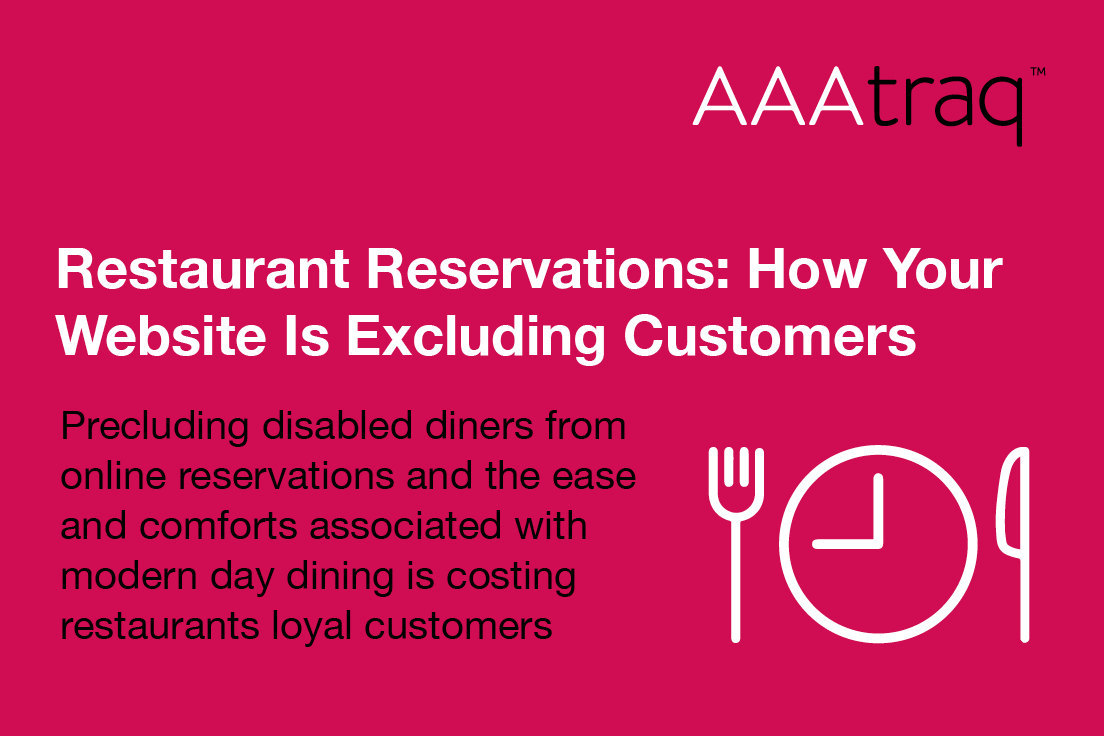Restaurant Reservations: Making Them Accessible to All
Feb 24 2022
Multiple pieces of technology are used by restauranteurs to assist with activities such as digital reservation making, automated check payment, and order placement. Such technology has been ushered in by the Digital Age and has made it so that customers enjoy a more relaxed dining experience.
At the same time, such technologies allow restaurant owners to experience more efficient service and turnover in their restaurants, thus making their businesses more efficient and profitable. While many individuals enjoy the benefits that enjoin a greater digital presence in the dining process, there is a sizeable group who have been further marginalized by aspects of it. Individuals with mobility impairments, visual impairments, and many other types have been ostracized by the lack of accessibility features offered by websites. Technology that was meant to make online reservation placement more inclusive has limited the access of visually impaired and mobility impaired users due to improper coding and labeling of form fields and information provided by website owners. Furthermore, other documentation essential to the reservation making process has made it such that disabled individuals don’t enjoy equity in access to information prior to making their reservation. This information includes restaurant accessibility features, menu readability by assistive technology, and parking information are sometimes hidden to disabled users.
The ability for a restaurant goer to reserve a table/seat at a restaurant via the internet has revolutionized the restaurant industry. The process for filling tables is more efficient for both the diner and the owner, thus making the dining process easier. As online reservation making platforms have evolved, more and more restaurants seem inclined to register, thus allowing individuals ease of access to these restaurants without having to make a call. Typically, while making a reservation, users have access to information about the restaurant, including the menu. Such information is vital to users with dietary restrictions and accessibility requests to make an informed decision on whether to dine at such a venue. For disabled users, information pertinent to the accessibility features of the venue should be made readily available like that which would if the prospective diner would be able to access if they were to call the venue.
What information is necessary to make a reservation? How does this information get to the restaurant? Most online reservation platforms require that diners provide the restaurant with the number of guests, time/date of the reservation, a name for the reservation and at least one method of contacting the guest (typically email and/or phone number). You might not have realized it, but to provide such information you likely just engaged with at least five different form fields. Such form fields often serve as a significant accessibility barrier to disabled individuals who make use of assistive technology when not properly coded. Forms are used on websites to collect information such as telephone numbers and emails in a contact form. For many websites, the form is the primary mechanism by which the user and the website can exchange information that can then be used by the website provider later. While many types of forms exist on a webpage, some examples include contact forms, customer feedback/support requests, account signup, and payment forms.
Each field in a form, otherwise seen as the area for data entry, requires a label to describe the purpose and type of information that is being requested in that field. These labels enable users accessing the website with a screen reader to understand the purpose and function of a given form field. Without these labels, individuals who are visually impaired may be unduly discriminated against, and a barrier to equality in communication and use with/of a webpage would exist. Improperly coded form field labels would function as a gatekeeping role in who can have access to functions of a website, and subsequently who may be able to engage in specific activities.
Accessibility functions on reservation platforms must make it such that disabled users have equitable access to make reservations online. Such features must make it so that disabled users can properly interpret and respond to the prompts on the page. Form fields aren’t the only accessibility provision important to the online reservation making process Alternative text, also known as alt text, is a written description of images or graphics and is an essential component of providing for a page that is accessible to disabled users who require assistive technology. Alt text, when not used correctly, inhibits visually impaired individuals from using assistive technology to provide them full access to the information in a manner that is not diminished by their disability status. In the reservation making process, information such as menus, restaurant policies displayed on graphics, or other visual representations may not be interpreted by users with disabilities if no alt text is used and might lead them to being disenfranchised by the system in use. Other important accessibility features include keyboard navigability (a function that enables the user to navigate a webpage without using a mouse), color contrast, and potential use of a voice function.
Furthermore, a restaurant’s liability does not end with the reservation software but extends to include the use of said information in the restaurant when the diner shows up. Restaurants must make sure that the information provided interfaces directly with any software used at the restaurant itself. Any information regarding accessibility requests must make it to the appropriate person to provide for the most accessible and accommodating experience for the disabled diner. Failure to translate such information to the physical environment on the part of the restaurant may be ground for civil action. In May 2021, Albert Dytch sued California restaurant Top Hatters Kitchen and Bar for not adhering to the accessibility request submitted when making his reservation. Such suits are increasing in frequency and have the potential to be catastrophic for smaller mom and pop restaurants.
Subscribe to AAAtraq and enjoy complete cover and peace of mind
